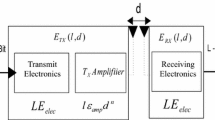Abstract
A common and critical operation for wireless sensor networks is data gathering. The efficient clustering of a sensor network that can save energy and improve coverage efficiency is an important requirement for many upper layer network functions. This study concentrates on how to form clusters with high uniformity while prolonging the network lifetime. A novel clustering scheme named power- and coverage- aware clustering (PCC) is proposed, which can adaptively select cluster heads according to a hybrid of the nodes’ residual energy and loyalty degree. Additionally, the PCC scheme is independent of node distribution or density, and it is free of node hardware limitations, such as self-locating capability and time synchronization. Experiment results show that the scheme performs well in terms of cluster size (and its standard deviation), number of nodes alive over time, total energy consumption, etc.
Similar content being viewed by others
Explore related subjects
Discover the latest articles, news and stories from top researchers in related subjects.References
S. Lindsey, C. S. Raghavendra. PEGASIS: Power-efficient gathering in sensor information systems. In Proceedings of IEEE Aerospace Conference, IEEE, Monana, USA, vol. 3, pp. 1125–1130, 2002.
O. Younis, S. Fahmy. Distributed clustering in ad-hoc sensor networks: A hybrid, energy-efficient approach. In Proceedings of IEEE INFOCOM, Hong Kong, PRC, vol. 1, pp. 640, 2004.
S. Soro, W. B. Heinzelman. Cluster head election techniques for coverage preservation in wireless sensor networks. Ad Hoc Networks, vol. 7, no. 5, pp. 955–972, 2009.
H. Abusaimeh, S. H. Yang. Dynamic cluster head for lifetime efficiency in WSN. International Journal of Automation and Computing, vol. 6, no. 1, pp. 48–54, 2009.
C. Bean, C. Kambhampati. Autonomous clustering using rough set theory. International Journal of Automation and Computing, vol. 5, no. 1, pp. 90–102, 2008.
S. Bandyopadhyay, E. J. Coyle. An energy efficient hierarchical clustering algorithm for wireless sensor networks. In Proceedings of the 22nd Annual Joint Conference of IEEE Computer and Communications, IEEE, San Francisco, USA, vol. 3, pp. 1713–1723, 2003.
A. P. Chandrakasan, A. C. Smith, W. B. Heinzelman. An application specific protocol architecture for wireless microsensor networks. IEEE Transactions on Wireless Communications, vol. 1, no. 4, pp. 660–670, 2004.
O. Younis, S. Fahmy. HEED: A hybrid, energy-efficient, distributed clustering approach for ad hoc sensor networks. IEEE Transactions on Mobile Computing, vol. 3, no. 4, pp. 366–379, 2004.
H. W. Chan, A. Perrig. ACE: An emergent algorithm for highly uniform cluster formation. In Proceedings of the 1st European Workshop on Sensor Networks, Lecture Notes in Computer Science, Springer, Berlin, Germany, vol. 2920, pp. 154–171, 2004.
J. Kamimura, N. Wakamiya, M. Murata. Energy-efficient clustering method for data gathering in sensor networks. IEIC Technical Report, Japan, vol. 103, no. 691, pp. 31–36, 2004.
M. Ye, C. F. Li, G. H. Chen, J. Wu. EECS: An energy efficient clustering scheme in wireless sensor networks. IEEE Transactions on Mobile Computing, vol. 3, no. 4, pp. 366–379, 2004.
M. Chatterjee, S. K. Das, D. Turgut. WCA: A weighted clustering algorithm for mobile ad hoc networks. Cluster Computing, vol. 5, no. 2, pp. 193–204, 2002.
S. Basagni. Distributed clustering for ad hoc networks. In Proceedings of the 4th International Symposium on Parallel Architectures, Algorithms, and Networks, IEEE, Fremantle, Australia, pp. 310–315, 1999.
M. Gerla, J. T. C. Tsai. Multicluster, mobile, multimedia radio network. Wireless Networks, vol. 1, no. 3, pp. 255–265, 1995.
A. K. Parekh. Selecting routers in ad-hoc wireless networks. In Proceedings of the SBT/IEEE International Telecommunications Symposium, Rio de Janeiro, Brazil, pp. 420–424, 1994.
A. Ephremides, J. E. Wieselthier, D. J. Baker. A design concept for reliable mobile radio networks with frequency hopping signaling. Proceedings of IEEE, vol. 75, no. 1, pp.56–73, 1987.
Author information
Authors and Affiliations
Corresponding author
Additional information
This work was supported by National Basic Research Program of China (No. 2010CB731800), National Natural Science Foundation of China (No. 60934003), and Educational Foundation of Hebei Province (No. 2008147).
Liang Xue received the B.Eng. degree in automation from Yanshan University, Qinhuangdao, PRC in 2006. He is currently a Ph.D. candidate in Yanshan University.
His research interests include protocol design of wireless sensor networks, cognitive radio networks, and industrial wireless networks.
Xin-Ping Guan received the master degree in applied mathematics in 1991, and the Ph.D. degree in electrical engineering in 1999, both from Harbin Institute of Technology, PRC. Since 1986, he has been with Yanshan University, PRC, where he is currently a professor of control theory and control engineering. In 2007, he also joined Shanghai Jiao Tong University, PRC.
His research interests include robust congestion control in communication network, chaos control, and networked control system.
Zhi-Xin Liu received the master degree in control theory and control engineering, and the Ph.D. degree in control science and engineering from Yanshan University, Qinhuangdao, PRC in 2003 and 2006, respectively. He is currently an associate professor in Yanshan University.
His research interests include network congestion control, network rate control, and routing protocol for wireless sensor networks.
Qing-Chao Zheng received the B.Eng. degree in automation from Sichuan Normal University, Chengdu, PRC in 2008. He is currently a master student in Yanshan University.
His research interests include clustering and routing protocol design for wireless sensor networks.
Rights and permissions
About this article
Cite this article
Xue, L., Guan, XP., Liu, ZX. et al. A power- and coverage-aware clustering scheme for wireless sensor networks. Int. J. Autom. Comput. 7, 500–508 (2010). https://doi.org/10.1007/s11633-010-0533-5
Received:
Revised:
Published:
Issue Date:
DOI: https://doi.org/10.1007/s11633-010-0533-5




